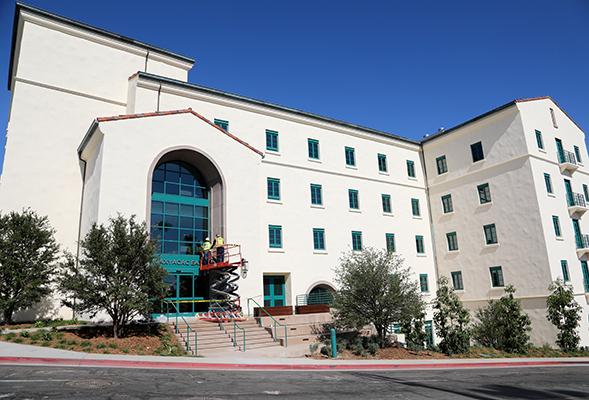What's New, SDSU? Construction and Renovation Updates
Studentsand dogswill enjoy the projects completed for the 2019-20 year, including an 800-student residence hall, imported trees and an upgraded recreation field.

A new residence hall is the highlight in a flurry of construction, upgrades and beautification projects for San Diego State University completed over the summer.
Huaxyacac—we’ll get to the proper pronunciation in a moment—continues the SDSU tradition of assigning Nahuatl names to campus residence halls and apartments. On Thursday, the first of its 800 student occupants began moving into the four-story structure, which boasts its own community market and coffee shop.
A completely refurbished recreation field to help meet growing demand, and a repaving project along a central walkway are among other new touches and upgrades to the campus as the 2019-20 academic year gets underway.
Here’s a closer look:
Huaxyacac
After two years of construction on a former parking lot along Remington Road on the west side of campus, the residence hall is now open. Comprising mostly two-bedroom units with a smattering of larger three-bed units, it’s the newest living space at SDSU since South Campus Plaza opened in January 2017.
In the language spoken by the Nahua people known historically as Aztecs, Huaxyacac is the name for the Oaxaca region of Mexico. It’s not pronounced the same, however, the name of the hall sounds like wah-she-YAH-cack. (To hear the name being spoken, click here.)
SDSU anthropologist Ramona Pérez said the name means place of the huaje or guaje trees (Leucaena trichandra), which are native to Mexico and Oaxaca. Huaxyacac will have two of them, placed in large pots rather than directly into the landscape because they are considered invasive.
“It is not an overly attractive tree, but is well known for its high protein seeds found inside a red pod,” said Pérez, chair of Aztec Culture and Education at SDSU. “They are an important part of the traditional diet. We decided that having the guaje tree as a primary focus would tie the name to this important food source.”
The hall is divided into an east and west side, each with its own courtyard. A rooftop patio is outfitted with plants, seating and study space.
Inside, there’s a lounge at the end of each hall except for the ground floor, and smaller sitting areas by the central elevators. In the restrooms, toilets and showers are all enclosed. The market, in a separate building, will be shared with adjacent Chapultepec Hall.
Other residential communities
A variety of renovations and upgrades await residents of six other residential communities.
At Maya and Olmeca, the renovations include updated restrooms and improvements to the kitchens and community spaces. Kitchenettes in Tacuba and Tepeyac were remodeled with new cabinetry, refrigerators, convection microwave ovens and flooring.
The community room at Villa Alvarado has been renovated with new flooring, additional study areas and a pool table. Mixquic apartments also feature a remodeled kitchen and new flooring.
Recreation field
The two-acre recreation field south of the Music building, officially known as ENS 700, has a new artificial turf to stand up to increased use, and new LED field lighting for night use. Landscape improvements also were part of the project, completed just before the beginning of the fall semester.
The $5 million project, led by Associated Students, provides increased recreational opportunities for students, including intramural sports, sport clubs and other informal drop-in opportunities. The new field has been striped for soccer, flag football and lacrosse.
The infill material for the artificial turf, ZeoFill, is an eco-friendly and highly porous material derived from natural substances. Project manager Amanda Scheidlinger said the substance reduces the field temperature by about 20° F compared with crumb rubber, a cheaper fill. It’s longer-lasting, partly by neutralizing ammonia—a helpful feature given the number of Frisbee-chasing dogs that also enjoy the field.
The project was funded with Associated Students fees.
Centennial Walkway
The walkway in front of Manchester Hall was rebuilt and smoothed out to correct uneven settling since its original construction in the mid-1990s.
In the second phase of a continuing, multi-year project, decorative pavers covering 10,000 square feet were removed, stored on pallets while the soil was reinforced, and then pounded back into place, one at a time.
Contractors estimate some 40,000 pavers were removed for the project.
PSFA Building
The Professional Studies and Fine Arts building is safe and fully open. Additional construction and repairs will occur in and around the building throughout the 2019-20 academic year.
Those projects include replacement of the roof, upgrading windows and replacing the entry doors; improvements to the HVAC and plumbing systems; restroom renovations; upgraded corridor finishes, flooring, and lighting; and the completion of fire/life/safety requirements.
Installation of the building’s new roof will begin in October and all construction and repair is slated to be completed by August 2020. Mitigation efforts and ongoing support for students, faculty and staff will continue to be offered. Project updates and other information will be shared via the Business and Financial Affairs website.
Work in progress
The Love Library roof is in the process of being replaced. Restroom renovation and complete plumbing repairs for the building are in the design stage.



